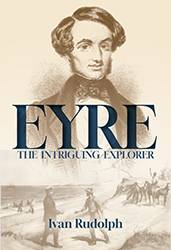Lake Torrens
Eyre’s fascination with Lake Torrens included finding out its overflow drainage pattern. Eyre intended using a barometer to decide a perplexing question – in which direction did the Lake Torrens basin fall? It was so flat the naked eye alone could not determine the gradient. His mercury barometers were too delicate to be lugged about on such a rugged expedition and had broken, their mercury irretrievably spilt. Consequently he had to go by his observations alone. In time he deduced Lake Torrens to be slightly above sea level and that its drainage would be into Spencer Gulf, down a muddy overflow creek that they had crossed previously without realising its significance. He believed correctly that the climate had changed and that Lake Torrens seldom flooded as far as the Gulf. (In fact Lake Torrens is slightly above sea level by approximately 14m. It has only filled once in the last 150 years, so consequently its drainage direction is pretty much academic. When it does overflow, it does so into Spencer Gulf as deduced by Eyre, along the watercourse he identified.)
At first, explorers and settlers believed Eyre’s 1840 concept of an “Impassable Lake Torrens Horseshoe” that hemmed in the Flinders Range. From his investigations and observations, it seemed logical.
In 1843, the then Surveyor-General of the colony, Captain Edward Frome, reached Mount Serle. He found the great lake to the east, as described by Eyre, but discovered an error of approximately 30 miles in its position, Eyre having placed it too far to the eastward. Besides one further overestimation of distance, made during a time of particular trauma, this is the only serious error of measurement that Eyre made out of hundreds – numbers of explorers and surveyors later on marvelled at his trademark accuracy, Big John Forrest and Peter Warburton being prominent examples. Returning to his field journal later to find the source of his error, Eyre discovered he had not allowed for magnetic variation in some of his bearings. When he did so, his positions for Mount Serle and Lake Torrens agreed with those of Frome.
Others who ventured into the region soon after Frome accepted the existence of a single encircling lake and found nothing to disprove it. However, the distance apart of his sightings had deceived Eyre. Instead of one giant lake, named by scientists Lake Dieri and which had existed there many centuries beforehand when the region enjoyed higher rainfall, there are now a number of smaller lakes occupying the same ancient basin, and routes can be found between them. For example, lying between Lake Torrens and Lake Eyre South is a passage approximately 50 miles wide across dry ground. Later the “Ghan” railway line was built to link settlements such as Beltana and Leigh Creek, within the circle of lakes, to Oodnadatta north of the circle.
Naming the circle of lakes clockwise from Lake Torrens, we find Lake Eyre South, then Lake Eyre proper, followed by lakes Gregory, Blanche, Callabonna and Frome.
Already by the 1850s many graziers had taken up land within the supposed Lake Torrens horseshoe, and in 1854 the government established Port Augusta at the head of Spencer Gulf, to serve the runs of the Flinders region. Port Augusta quickly developed into one of South Australia’s major ports for wool, minerals and wheat. Typically, Eyre had discovered land more valuable than he had supposed it to be.
Eyre’s contention that there was a giant horseshoe lake enclosing the Flinders Range discouraged further exploration by men and horses from the head of Spencer Gulf towards the Centre. Then in 1858 Benjamin Babbage, Peter Warburton and Augustus Gregory all found passages between the great salt lakes. Following their discoveries, many routes opened up to the north. Stock stations, mining towns and settlements developed both within and outside the circle of salt lakes.
Lake Eyre today comprises, when dry, 6000 square miles of gleaming white salt. When it fills with water, the bird life there is incredible, and it remains a mystery how coastal birds near Adelaide can sense the filling of the lake in advance of the event and fly there. Even in Eyre’s time, the strange behaviour of birds flying into the dry interior flummoxed him and Sturt because it suggested an inland sea might exist there. It had, once, previous to human settlement.
Ironically, there have been suggestions over the years which, if adopted, would produce Eyre’s mythical horseshoe lake. They are based on the salt lakes besides Lake Torrens being below sea level. It follows that a giant overland pipeline from the ocean could carry seawater into Lake Frome in the east, which would then overflow into the nearby lakes one by one all the way around until a giant sheet of water reached Lake Torrens in the west. Amongst other advantages, wonderful birdlife would proliferate and be a massive tourist attraction throughout the year, not only on the rare occasions that Lake Eyre floods. A significant fish farming industry could also thrive there. Some suggest the whole ecology would come to life and perhaps the inland rainfall would improve as a consequence.
However, in this modern era of “leave it alone in case we spoil things”, it is not likely to happen.
In retrospect, because of Eyre’s extraordinary bravery and desire to succeed, he might well have perished had he penetrated into the parched Simpson Desert beyond the ring of lakes. He expressed this view himself later. As he saw it, a Higher Being prevented him from finding a passage into the unforgiving desert beyond the Flinders because, having horses and not camels, they could not have survived long there.



